Winter’s grip is loosening. You’re dying to fish. Unfortunately, those super-early-season
bites can be the toughest to score thanks to cold, dirty water and sluggish targets. Have no fear. This quick-hitter guide to early-spring fish locations and habits will get you on the fast track to a bent rod. Just remember to check local regulations because season openers for many species vary from state to state.
Learn how to subscribe to the new Field & Stream magazine here!
Blue Catfish
Where: Virginia guide Chandler Puryear says that some of his biggest James River fish fall in the winter and very early spring. During these times of year, he’s targeting depressions within shallow flats as well as shallow structures, often in less than 10 feet of water.
Why: Blues remain active when the water is cold. Since forage like shad and herring become scarce now, they won’t pass up an opportunity to feed when they get it. Though Puryear still catches fish in deep holes, many cats slide shallow where the water will be slightly warmer.
How: It’s hard to beat soaking forage native to the body of water you’re fishing. For Puryear, that’s gizzard shad. The fresher and bloodier the chunk, the more likely it is to get sucked up.
Bluegills
Where: According to Wisconsin guide Tim Hyvonen, if some green weeds survived the winter in your home lake, you’ll find bluegills concentrated in and around them. If all the weeds die out, the fish will often be suspended in 8 to 15 feet of water.
Why: Hyvonen says that at this time of year, bluegills just want to be in the warmest water they can find, so don’t overlook areas with green vegetation as shallow as 2 feet. Since the north ends of any lake or pond often receive the most sunlight, Hyvonen says they’re a good place to start.
How: As the water temperature ticks up, bluegills will start to feed heavily in preparation for the spawn. Hyvonen sticks to the tiny ice jigs he has been using all winter, tipping them with wax worms, but now he presents them under a slip float.
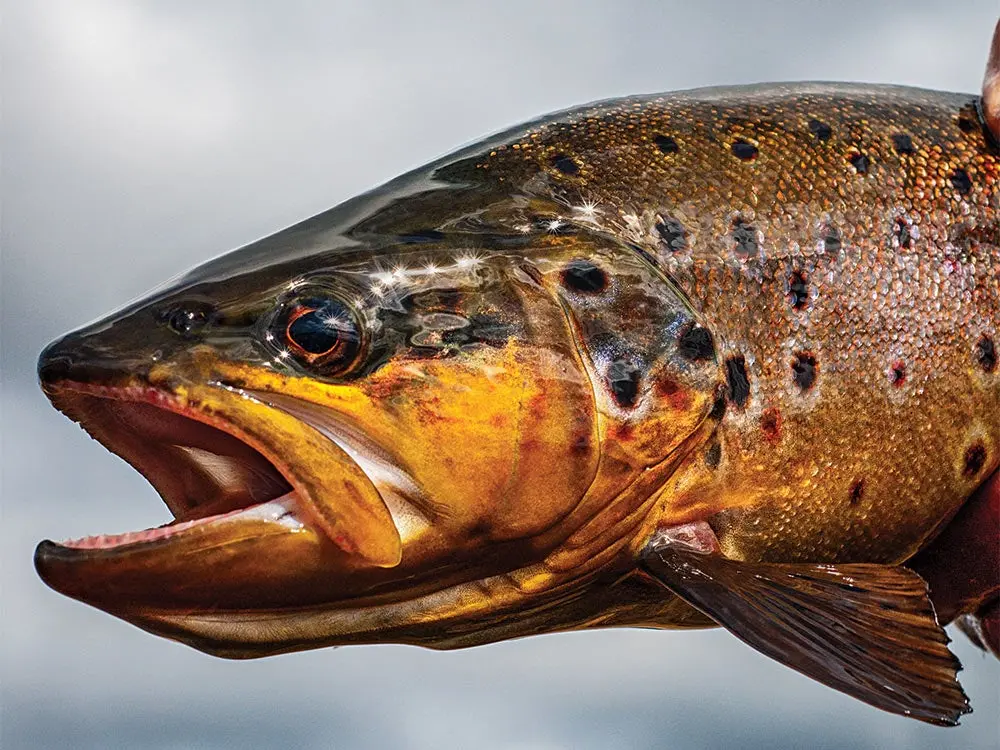
Brown trout won’t be very aggressive early in the spring, so mimic small food items like midges Baetis mayflies to fool fish. Brian Grossenbacher
Brown Trout
Where: Early spring conditions often mean high, cold, and dirty water for trout anglers. Under those conditions, veteran New York guide Joe Demalderis knows that he’s going to find browns tucked in tight to the bank. If the water happens to be flowing at more normal rates, he concentrates on slower water with some depth.
Why: Demalderis says that browns are pretty shut down until the water temperature begins climbing into the 40s. Since browns don’t want to expend energy, they flock to soft banks and holes. What’s important to remember, however, is that the fish won’t be overly aggressive.
How: Nymphs that mimic early stoneflies and Baetis mayflies are always safe bets; however, Demalderis cautions not to rule out streamers. The trick to success with them is to make precise casts to likely holding areas and work slowly. Jigging the streamer in place is very effective in cold water as well.
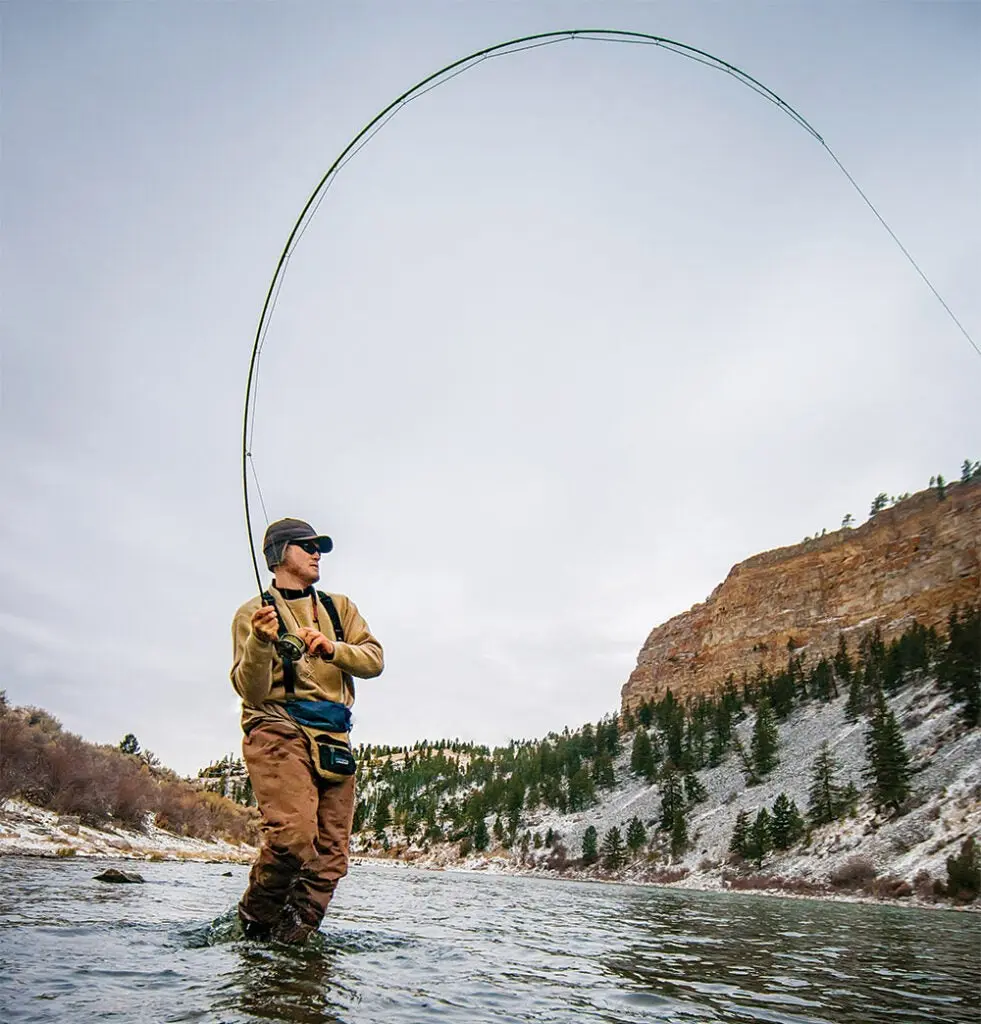
Cold Calling: In most early-season fisheries, particularly in the North and Midwest, success with any given species hinges on slow presentations and finding water a degree or two warmer than the main body. Brian Grossenbacher
Chain Pickerel
Where: When the ice melts on lakes, bogs, and ponds loaded with chains, it’s hard to go wrong targeting shallow water that has access to deep water close by. If there are remnants of milfoil or decayed lily pads in the area, that’s a plus. If not, concentrate on stumps and deadfalls.
Why: Pickerel will slide shallow to soak up the extra bit of warmth the sun provides during the heat of the day. Their forage will be shallow at this time of year too. Don’t be shocked to find them waking after your lure in less than a foot of water; however, deep edges near shallow flats are also prime.
How: Stickbaits, jerkbaits, and in-line spinners are all top lure choices. Cast them around any shallow structure and over the drop, working them back from deep to shallow.
Channel Catfish
Where: Early-season channel catfishing can be some of the best of the year as long as you’re strategic about where you wet a line. In rivers, focus on slow eddies and soft banks. In lakes, sheltered coves or the lee sides of points are often productive.
Why: The winter months are hard on channel cat forage. Species like shad often experience some level of die-off when temperatures drop. However, decomposition slows in icy water. This means that come early spring, cats waking from the cold have lots of dead baitfish on the bottom to eat. These dead forage species often collect in areas with little to no current.
How: Although matching local forage is always wise, hungry channel cats are not likely to snub baits like chicken livers even if they’re predominantly feeding on winter-killed baitfish.
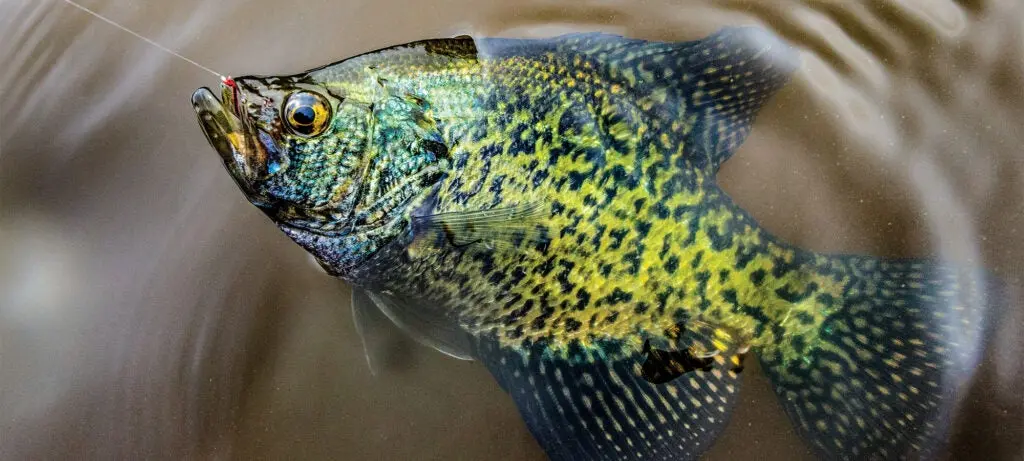
Crapshoot: Looking for early-season crappies? Start your hunt in deep creeks. Tom Martineau / The Raw Spirit
Crappies
Where: According to Kentucky-based tournament pro Tony Shepherd, it’s hard to beat a creek with depth and plenty of structure in the early spring.
Why: Crappies move to shallow flats to spawn when the water reaches the upper 50s, but they tend to congregate in creeks prior to making that shift. Shepherd says water clarity is a big factor, noting that in clear to lightly stained water, he’ll find more fish around stumps and stake beds along the creek banks. If the water is dirty, they’ll be suspended in deep water within the creek.
How: Shepherd predominantly relies on tiny jigs at this time of year, noting Jenko’s Fringe Fry as a favorite. He’ll fish them on a 1⁄16-ounce jighead and run them 2 or 3 feet behind a 1⁄2-ounce sinker. He says this rig gives the jig the best action when slow-trolling, which he leans on to cover lots of water.
Flathead Catfish
Where: Early spring is far from a peak time for flatheads, but according to Pittsburgh-area flathead ace Joe Gordon, if he had to hit the river in March, he’d go straight to the nearest warmwater discharge.
Why: In any water that’s below 55 degrees, flatheads are pretty comatose. Gordon says early-season success relies solely on finding the warmest water you can—even if it’s only a degree or two warmer than the rest of the lake or river—and hoping for one or two bites.
How: According to Gordon, although flathead fishing is a nighttime game most of the year, hunts now should happen during daylight hours. Live baits might score a bite, but fresh chunks are likely to produce more hits, especially if you downsize them a fair amount and use smaller hooks to make the morsel as effortless as possible for a cold cat to suck up.
Lake Trout
Where: Veteran Colorado lake trout guide Bernie Keefe says that when the ice comes off, you’ll find lakers very close to their food source, which often means shallower than you’ll find them for most of the year—a big plus for shorebound anglers.
Why: Lakers don’t have to retreat to the depths to find the colder water they prefer in early spring. Subsequently, during this time, forage like suckers and smaller trout will be shallow, looking for warmer water. Though the scenario is fleeting, it’s during this window that Keefe scores monsters in as little as 3 feet of water.
How: Early spring is arguably the best time of year to hook into big lake trout with many methods that would be impractical later in the season. Keefe casts soft-plastic swimbaits and crankbaits in areas where deep water transitions quickly to shallow shelves and flats. Catching lakers on big streamers in these areas is also possible for the devoted fly guy.

Largemouth bass won’t move into shallow water until it begins to warm up to 55 degrees. Tom Martineau / The Raw Spirit
Largemouth Bass
Where: Depending on where you live, largemouths could be very shallow or very deep. It all hinges on water temperature, making anything from shallow flats to deep channels and offshore bowls likely hotspots.
Why: Largemouths move shallow to spawn when the water hits 55 degrees. In the South, that can be as early as late February, in which case early spring can be prime for hunting bass on beds. In the North, bass are often suspended in deep water and chasing shad schools after ice-out. In the places in between, pre-spawn fish gravitate to and feed in deeper channels and along drop-offs close to where they’ll eventually spawn.
How: For suspended fish, vertical-jigging slab spoons and bladebaits can be highly effective. True pre-spawners often fall to squarebill cranks banging off cover, while bedded bass will attack almost any swimbait or soft plastic you drop on the bed.
Muskies
Where: To find early-season muskies, you’ve got to find water that’s warmer—even if only slightly—than the main lake or river. This makes protected bays and back eddies excellent places to hook your first of the season.
Why: Forage like suckers, carp, and bluegills gravitate to the shallows following ice-out, and muskies know where to find their food. Muskies are also cold-blooded, so the warmer their body temperature, the more likely they are to feel the urge to feed.
How: Slow presentations can be most effective in the early season. Opt for lures like Bull Dawgs, crankbaits, and glide baits that can be worked with a wide range of speed, as opposed to bucktails that have to be cranked quickly to maintain their action.
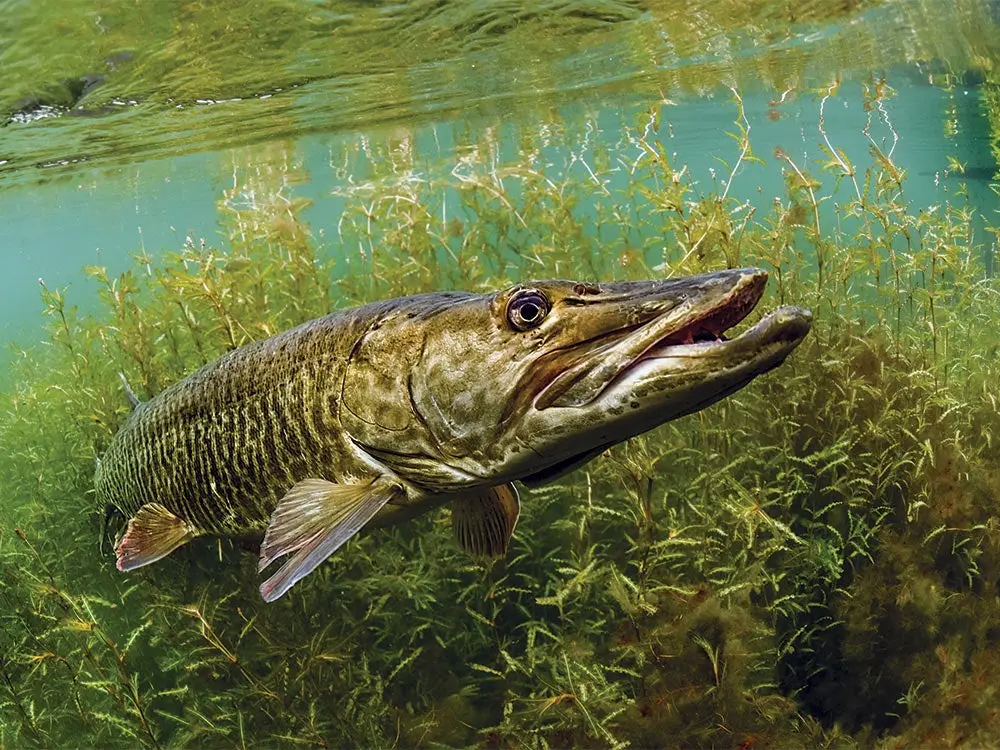
When panfish and suckers move into shallow water after ice out, big muskies looking for a meal will follow. Jason Arnold
Northern Pike
Where: Early spring can be a riveting time to target pike. In many areas, sight-casting to giants is a real possibility, and you’ll often find them in shallow, weedy water. Trophies can fall in 5 feet of water or less.
Why: Shallow water heats up a lot faster than deep water, and once the ice is gone, big pike know they can warm up by sliding into coves and onto flats. All the forage species they crave are doing that too, which means you can experience a true feeding frenzy in hardly any water with high-caliber fish that will spend the rest of the year down deep.
How: If it moves like food, there’s a good chance an ice-out pike will try to kill it. Anything from huge streamers to topwater lures to glide baits and soft plastics that skim enticingly over the shallow weed tops is worth casting.

Rainbow trout begin thinking about spawning when water temperatures hit 40 degrees, so watch for fish migrating up and through riffles. Sam Zierke/Lance Krueger
Rainbow Trout
Where: Assuming the river is running high and cold in the early season, rainbows are going to move to the banks to get out of the heaviest flows. However, if the river is running at a normal level, rainbows are more apt to hold in faster water than browns at this time of year. Classic riffle water and choppy runs with medium speed and depth can both produce.
Why: Rainbows spawn in the spring as soon as the water temperature breaks 40 degrees, often making redds in the riffles above pools. It’s largely frowned upon to target these fish. However, because spawning can occur in waves, you’re still likely to hook some in less spawning-friendly areas.
How: Black stonefly nymphs are hard for rainbows to resist, but sometimes a juicier meal like a Woolly Bugger makes the play faster. Fish it slowly like a nymph, letting it wave and breathe in the current. Running an egg fly or San Juan worm ahead of it is never a bad idea.
Redfish
Where: Early-spring red locations vary depending on where you are in the country, though as a general rule, expect the big bulls to be well offshore. Smaller reds, however, often school up in the backcountry shallows, providing some of the best sight-fishing opportunities of the year.
Why: With the exception of the Mississippi Delta and a few other locations, genuine bull reds can be tricky to find. Along the Atlantic Coast, however, cold water temps often force the smaller nonmigratory reds to seek out warmth en masse. That means in places like North and South Carolina, it’s possible to find dozens if not hundreds of reds together in one cove or channel.
How: A piece of fresh shrimp on a jighead or plain hook will rarely get snubbed. If bait isn’t your game, opt for jigs and weighted crab and shrimp flies. Work slowly for these often lethargic fish, letting your offering puff sand and mud as it moves.
Seatrout
Where: Many speck hunters roll their eyes when you mention March. Although it can be a tough time of year, huge opportunities exist on skinny flats if you know how to time a mission just right.
Why: Seatrout spend the winter in most of their range holed up in deep water. Come March, those first few warm days of the year will prompt them to feed, and they’ll move onto the flats, even if only for a brief window during the day. Because forage can be scarce at this time of year, it’s not uncommon for them to hit anything that moves.
How: Topwater Spook-style baits and rattling baits draw these sound-oriented predators in like a magnet. If you want to add some scent to the equation, a fresh shrimp worked under a loud popping cork can be downright deadly.
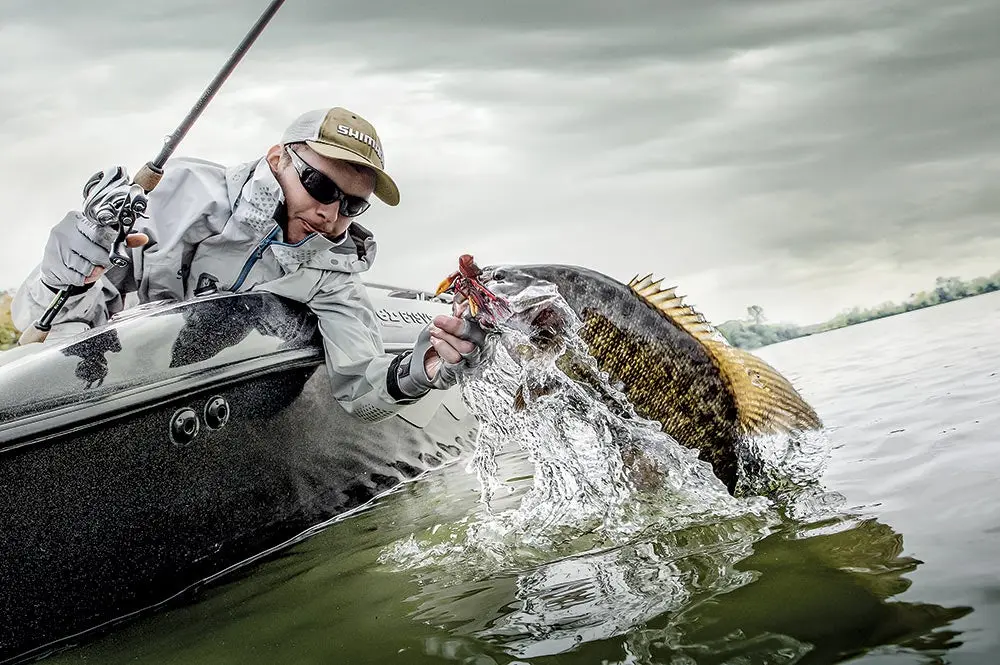
Smallmouth aren’t overly aggressive until the water temperatures warm, so work baits along the bottom. Tom Martineau / The Raw Spirit
Smallmouth Bass
Where: In swollen, dirty rivers, smallmouths will congregate in the paths of least resistance, which is typically tight to the bank in areas with slower current and moderate depth. In still waters, target deep holes with quick access to shallow feeding grounds.
Why: Smallmouth bass don’t spawn until the water reaches the low 60s. Prior to that, they’re often grouped up, so if you find one, you often find a pile. These pre-spawn fish are ready to feed, though they’re not always overly aggressive, often making finesse tactics critical.
How: In lakes, a bladebait can work wonders for fish hugging the bottom in deep water. A slowly dragged tube will also score in this scenario. In rivers, forcing chilly bass into a snap decision can be the ticket, making spinnerbaits and swimbaits prime choices.
Snook
Where: Late winter and early spring are tough times for snook, according to Port St. Lucie, Florida–based Capt. Zach Miller. During this seasonal transition, it can be difficult to come up with a consistent pattern. Bites can come anywhere, from under shallow docks to on the bottom in deep water. It all depends on temperature.
Why: Miller says that all the snook will ultimately make their way to inlets to stage before running the beaches to spawn. When they stack up in those inlets, the fishing can teeter on too easy. Prior to that staging, however, the snook are in limbo and often change location throughout the day. As a general rule, if the water temperature is below 70 degrees, finding them shallow is unlikely.
How: According to Miller, if you find a snook tucked under a dock or along a seawall now, it’s probably not going to pass up a live shrimp or pilchard. If the temperatures are too cold for them to be there, he’ll switch to flair jigs or weight those live baits and probe transitional areas along channel edges in anywhere from 8 to 30 feet of water.
Steelhead
Where: Not nearly as many anglers play the spring steelhead game along the Great Lakes shoreline as do the fall. That’s a mistake. To bow up now, concentrate your efforts on deep pools, tail-outs, and runs with moderate flow, particularly at the low ends of rivers.
Why: While some Great Lakes tributaries experience a spring run of inbound steel, most are holding fish that have been in the river all winter. These “drop-backs” will feed heavily on their way back to the lake. The trick is timing your attack. A quick jump in water level is often the catalyst that gets these fish pushing downstream.
How: Spring steelhead will eat egg beads, egg flies, and spawn as quickly as they did in fall and winter. However, drop-backs can be more aggressive than they were during the cold months, and therefore much quicker to smack a swung streamer or in-line spinner.
Striped Bass
Where: Although it’s possible to connect with migratory stripers in the ocean in very early spring, the majority of anglers hunting stripers now are after the resident fish that post up in back bays and rivers throughout most of their Northeast range. Depth and water temperature play the most vital roles in their success.
Why: Pre-spawn stripers often congregate in deep holes at the low ends of rivers, or in channels adjacent to shallow tidal flats. If the mud on those flats is dark, all the better, because it will absorb more sunlight and warm the water on the flat faster. While early-season bass may not be super-aggressive, they do need to feed, often giving anglers a quick window of opportunity as they turn on during tide changes or sometimes during slack tide.
How: Stripers can be lazy at this time of year, which is why bloodworms, clams, and sandworms are some of the most productive baits. These are the natural menu items these fish find on the flats, and it takes little effort to eat them. Soaking these baits is the fastest route to your first striper of the year, but don’t rule out smaller soft plastics around warmwater discharges or any time the water temperature jumps above 45 degrees.
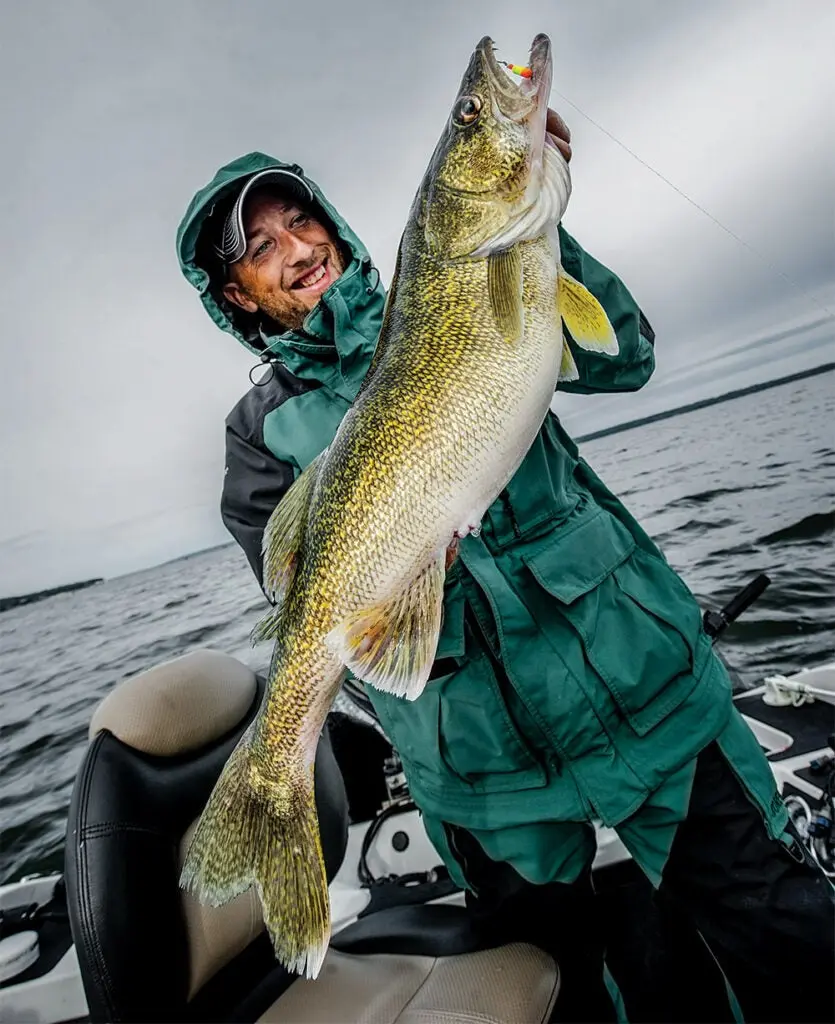
Walleyes spawn in the spring, so look for fish congregating around tributary mouths. Lee Thomas Kjos / The Raw Spirit
Walleyes
Where: Walleye guide Ross Robertson fishes the ice hard, but as soon as that ice is gone, he wastes no time firing up his boat. In the early open-water season, he’s concentrating most of his efforts on mudflats adjacent to deeper water and around river mouths.
Why: Walleyes spawn in spring, and while they won’t get busy until the water rises above 50 degrees, they stage and stack close to where that action will eventually happen. In closed bodies of water, that’s in areas with transitional depths and a soft bottom. If there’s a river entering your home lake or reservoir, you’ll find walleyes stacked at the mouth prior to running up to spawn. Likewise, in large rivers, the fish will run smaller tributaries to spawn, making creek mouths prime targets for early action.
How: No matter where you target your walleyes, Robertson says, slow presentations are key. He’ll often anchor and, using vertical ice-fishing tactics, drop a jig tipped with a minnow. Slow-trolling crankbaits close to the bottom can also be highly effective.
Yellow Perch
Where: Ready for that first fish fry of the season? To get things sizzling, target shallow areas of the lake right after ice-out. If the shallows in your local water feature some rocks and vegetation, odds increase that the perch are piled in.
Why: Unlike other species, yellow perch don’t develop their eggs until right before they spawn. That means they have to feed heavily to keep up their weight and help those eggs grow. Their food sources are going to hang shallow, which is also where the perch will spawn.
How: When the water is still ice-cold, lean on jigs and spoons, and work them very slowly near the bottom. You may find that a more aggressive presentation scores more bites, but start slow and increase your speed until you dial in exactly what flips their switch.
![Field & Stream [dev]](https://images.ctfassets.net/fbkgl98xrr9f/1GnddAVcyeew2hQvUmrFpw/e4ca91baa53a1ecd66f76b1ef472932b/mob-logo.svg)





